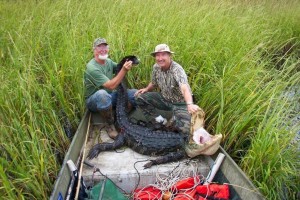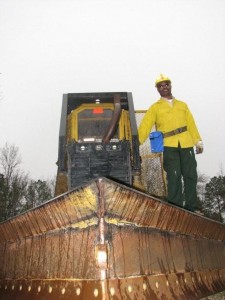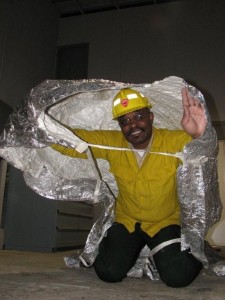 I hurled the harpoon at the large gator at a range of 10 yards and luckily it found the mark! The gator dove to the bottom of the Savannah River and I struggled to hold on to one of the most dangerous and aggressive creatures in Georgia. The small braided nylon rope did not seem strong enough to hold the thrashing ten foot gator and I really started thinking, “do I really want to pull this wild animal with very big teeth up next to the boat?”But I was committed to the hunt and as I pulled the very mad gator in, he rolled and snapped his huge jaws at every thing in sight. Once I got him up next to the boat, he chopped his big, sharp teeth down on the gunwale, and I was glad it was not my arm as large dents and bare paint was clearly present went he let go. As he was looking for something else to bit into, I and hunting guide Jack Douglas held on for dear life and tried to wear the gator down. The gator rammed the boat repeatedly and water was splashing everywhere, but we were past the point of no return! Soon however, we wore the gator down and I dispatched him with a shot my 357 magnum pistol. It was exciting and very challenging to stalk the gator and with it in the boat, I concluded one of the most memorable hunts of my life, but this type of hunting is not for the faint- hearted!
I hurled the harpoon at the large gator at a range of 10 yards and luckily it found the mark! The gator dove to the bottom of the Savannah River and I struggled to hold on to one of the most dangerous and aggressive creatures in Georgia. The small braided nylon rope did not seem strong enough to hold the thrashing ten foot gator and I really started thinking, “do I really want to pull this wild animal with very big teeth up next to the boat?”But I was committed to the hunt and as I pulled the very mad gator in, he rolled and snapped his huge jaws at every thing in sight. Once I got him up next to the boat, he chopped his big, sharp teeth down on the gunwale, and I was glad it was not my arm as large dents and bare paint was clearly present went he let go. As he was looking for something else to bit into, I and hunting guide Jack Douglas held on for dear life and tried to wear the gator down. The gator rammed the boat repeatedly and water was splashing everywhere, but we were past the point of no return! Soon however, we wore the gator down and I dispatched him with a shot my 357 magnum pistol. It was exciting and very challenging to stalk the gator and with it in the boat, I concluded one of the most memorable hunts of my life, but this type of hunting is not for the faint- hearted!
Alligator hunting is now legal in Georgia with a special permit available from the Georgia DNR and I was able to apply for and get drawn for the quota permit a few years ago. I signed up with well known Nuisance Trapper Agent Jack Douglas of Savannah to assist me with my first gator hunt and I am very glad I did, as Douglas is probably the most experienced and knowledgeable gator guide in Georgia with hundreds of gators to his credit. To gator hunt you must first attach a line to it before you dispatch it, because when shot, the gator can sink to the bottom of the water and be lost without the line. But how to you attach a line to a gator? It is sort of like grabbing a tiger by the tail, and as you can imagine, the task is not easy. The rules say the line can be attached by an arrow, harpoon, snare, gig or snatch hook. Douglas says there are advantages to every method, but he prefers to snatch hook the gator with a large, weighted, treble hook cast out from a strong salt water fishing reel. He calls it “casting for gators” and he is a master of the technique. On the morning of our hunt, we cruised up and down the Savannah River, not far from downtown savannah, and looked for the distinctive sight of gaiters’ head above the water line. Gators are reclusive animals and often they slipped under the water before we could get close enough for a cast. Douglas says the trick is to cast the 200 pound test line over the gator’s back and carefully take up the slack line with out alarming the gator. Then when the line starts to tighten up, he jerks the line strongly in hopes of sinking the treble hooks into the gator’s hide. It can be a hit or miss effort, but Douglas is very good at the technique. The goal is to hook the gator and then reel him in close enough to use the harpoon, as the casting line is not strong enough to hold a fighting gator, but good enough to close the distance. After a couple of failed efforts to get close to a big gator, we finally saw the gator cruising in open water and Douglas was successful in casting over the gator and getting the hooks into him. Then Douglas slowly reeled in the quickly fleeing gator as it towed us around the river and at the right time, I was able to sink the harpoon into him as described above and the real fun began to bring in the gator!
There are approximately 200,000-250,000 alligators in the state of Georgia and their numbers are growing. Alligators occur from the southern tip of Texas to the northeastern part of North Carolina. In Georgia, they are typically found south of the fall line (which roughly traverses the cities of Columbus, Macon, and Augusta). There is no evidence that alligator populations reproduce north of the fall line and any found in these areas have probably been illegally relocated by humans. Alligators usually remain in the area where they were hatched for two to three years before establishing their own range. Females generally have small home ranges while males may occupy a home territory of more than two square miles. Severe drought conditions may cause alligators to move considerable distances in search of suitable waters.
Alligators are America’s largest reptile. Adult males can get up to 14 feet long and weigh more than 1,000 pounds. The largest alligator on record was found in Louisiana in the early 1900s. It was 19 feet, 2 inches long and wide enough for two men to fit inside its belly. In the wild, alligators have a life span of 35 to 50 years. You should never get closer than 15 feet to an alligator. If the gator opens its mouth and/or hisses you should immediately back away. Adult alligators can run as fast as 30 mph on land for short distances. According to the DNR, there have been eight recorded alligator attacks in Georgia and one fatal attack. That fatal attack occurred on Skidaway island in October 2007 when Gwen Williams, age 83, was found floating dead in a canal. Her injuries were consistent with an alligator attack, but the exact circumstances are unknown. Trapper Agent Jack Douglas was called in to trap the gator and later, a necropsy on the gator and its stomach contents confirmed it was the guilty gator.
Alligators are carnivores that like to feed at night. They eat mostly fish, snakes, turtles, waterfowl, small mammals, even dogs, and other alligators. Once ,while I was in Bond Swamp Refuge, near Macon, I saw a group of turtles sitting on a log above the water. All of a sudden the turtles started to jump off the log and a large gator leaped from the water and grabbed one before it hit the surface. The sound of the gator’s jaws crushing the turtles shell was unmistakable and there was one less turtle in the swamp! They swallow their food whole, as their teeth are made for grabbing and holding, not cutting. If a gator kills prey too big to eat all at once, it will often hide it and come back later when the prey has reached a state of decay and softened up for easier swallowing. Alligators can live in salt water and are often found in brackish water along the Georgia coast. Alligators occupy a variety of wetland habitats in Georgia. They are found in marshes, swamps, rivers, farm ponds and lakes in the wild, but also have been found in ditches, neighborhoods, drainage canals, roadways, golf course ponds, and sometimes in swimming pools. During courtship and breeding, April to May, alligators prefer open waters. During the remainder of the year, males prefer open and deep waters while females seek out nesting habitat in secluded areas with shallow water and heavy vegetation.
*Keep in mind that there is an element of danger involved alligator hunting. The techniques, equipment and practices described here are only provided to demonstrate practical techniques. Hunters should be aware that many experienced Agent alligator trappers, using similar techniques, have been bitten and some seriously injured. You are urged to use extreme caution when handling Alligators. If you are inexperienced in handling alligators, the DNR encourages you to obtain the assistance of an experienced guide and plan on attending one of the voluntary training and orientation sessions. To apply for an alligator quota permit and learn more about the rules and regulations, go to www.gadnr.org. To contact DNR Trapper Agent and hunting guide Jack Douglas, call 912-658-5594. Good gator hunting!









